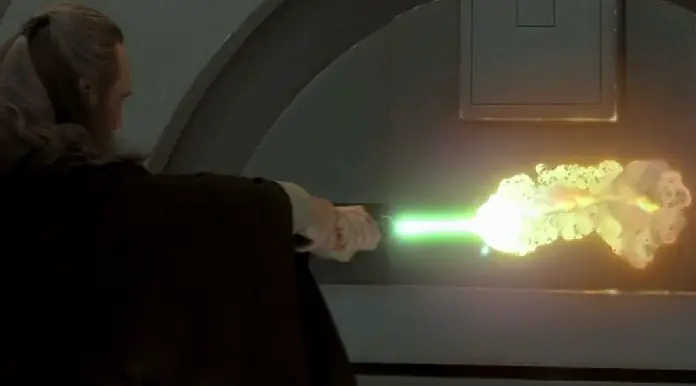What Is a Lightsaber Made Of & What Powers It? Star Wars vs. Real Life

Join the community on Reddit for the latest Marvel & DC news!
The weapon of a sophisticated fighter in the world of Star Wars, a lightsaber is the perfect weapon for a Jedi Knight. This is a device that can produce a powerful plasma blade that’s capable of cutting through steel like a hot knife through butter, and that means that a lightsaber has to have a strong power source for it to be able to produce such a powerful blade. So, what is a lightsaber made of, and what powers it?
A Kyber crystal is what powers a lightsaber through the energy that comes from a power cell. The crystal basically amplifies the power that comes from the power cell so that the lightsaber can produce a blade that is strong enough to cut through almost every material in the galaxy.
There are a lot of things that make a lightsaber work, but the truth is that the Kyber crystal has always been the most important component of this device. That’s because of the fact that the crystal is the very life source of the blade. As such, every Jedi must find their own Kyber crystal to construct their lightsaber. Now, let’s talk more about what powers a lightsaber.
How does a lightsaber work?
There is no doubt that the lightsaber is one of the most iconic weapons of all time and is arguably right up there at the top in terms of the most iconic weapon in the history of sci-fi.
That’s because there has always been something special about a device capable of producing a blade made out of plasma and powerful enough to cut through some of the thickest objects imaginable in the world of Star Wars.

Of course, the entire concept of a lightsaber is just as interesting as its ability to cut through steel like a hot knife through butter. And that’s because this weapon has one of the most unique designs in the world of Star Wars in the sense that only a true Jedi can create one.
Doctor Cuata, an expert in Kyber crystal research in the world of Star Wars, said:
“A lightsaber has five main parts. The power cell, the casing, the focusing lens, the emitter, and, of course, the crystal. The rest is just wiring, an on/off switch, and whatever fancy extra bits people want to build in. All in all, though, it’s a pretty simple device.”
Basically speaking, the lightsaber doesn’t seem to be a very complex device that is difficult to construct. Even younglings can construct their own lightsabers as long as they have the parts needed to do so. The tricky part, however, is acquiring the material capable of powering an entire lightsaber.
The Kyber crystal is what powers a lightsaber and is the very source of the blade that a lightsaber can emit. But the Kyber crystal is not why a lightsaber has a blade. Instead, it is simply a crystal that can exponentially amplify the power coming from an energy source. And this is where the power cell comes into play.
It might be true that the Kyber crystal is the heart of a lightsaber, but the power cell is the object that allows the crystal to produce its blade. The power cell provides the energy that turns the lightsaber on, as the Kyber crystal amplifies this energy to produce a blade that is hot enough to cut through entire limbs without much effort.
In that regard, Kyber crystals cannot produce energy but can hold energy and multiply it exponentially.
But the Kyber crystal remains the most important part of a lightsaber because the saber could never work without it. It might be true that a power source is still needed to turn the saber on. But there are different power sources that a Jedi can use to power up the lightsaber. On the other hand, the only object capable of turning a power source’s energy into a blade is the Kyber crystal.
In canon, only the Jedi are capable of attuning with a Kyber crystal to make it viable for use. That is why non-Jedi or those who aren’t strong in the Force cannot construct lightsabers even if they get their hands on a Kyber crystal. The Jedi need to use the Force to attune with the Kyber crystal, and that’s why only Jedi are capable of constructing lightsabers.
Not even the Sith are capable of attuning with a Kyber crystal, and that’s why they have to steal a lightsaber and use the dark side of the Force to corrupt an attuned Kyber crystal and make it “bleed.” And this is where the exclusivity of the lightsaber comes into play, as the Kyber crystal can only be used by a Force user that’s aligned with the light side of the Force.
Can a lightsaber exist in real life?
The thing about the lightsaber is that the way that it works in the Star Wars universe is pseudoscience at best because the science used in the Star Wars galaxy doesn’t exist in our own universe. For example, we don’t have Kyber crystals that could amplify the energy from a power source. So, does that mean that a lightsaber is impossible in real life?
Theoretically, lightsabers are actually possible to build in real life because physicists and engineers were able to lay the theoretical groundwork needed to create a lightsaber. For example, Celebrity physicist Michio Kaku once estimated that creating a plasma blade that could act as a lightsaber was possible.
Meanwhile, these guys at Hacksmith Industries could create their own lightsaber. The lightsaber they created could hold a physical blade around the proper length of a lightsaber. And it was able to burn at a temperature of 4,000 degrees Fahrenheit, which was hot enough to allow the blade to cut through a thin sheet of metal.
But what needs to be considered is that lightsabers are supposed to burn somewhere higher than 36,500 degrees. So, the fact that the Hacksmith Industries people could make a lightsaber that could burn at 4,000 degrees was just the starting point because we know that lightsabers are supposed to cut through metal effortlessly. And the problem with their lightsaber is that it had to use a large tank of propane gas for power.
In theory, a lightsaber can be constructed in real life. The problem is that we are yet to reach the technological capacity to construct a lightsaber that could burn more than 36,500 degrees Fahrenheit without using an entire tank of propane. And according to Michio Kaku, we don’t have a handheld power source that is strong enough to power something that could produce that much heat.
Of course, the world of Star Wars doesn’t even use the power of the power cell to create the blade. Instead, the power cell merely lends the energy that the Kyber crystal amplifies to create the blade of a lightsaber. And because our real-world technology doesn’t have a Kyber crystal that could amplify the energy of a power source, a real-world lightsaber needs a powerful power source that no longer needs to be amplified.
But the biggest problem here is that, according to Brandon Weigel, no one should be able to hold a real-life lightsaber that produces more than 36,500 degrees of heat because the autoignition temperature produced by something as powerful as that should burn off any biological matter that’s about a football field away from the source of the heat. In plain terms, a real-life lightsaber capable of producing 36,500 degrees of heat would produce so much heat that anything close to it should feel the heat and burn off.
Take a bonfire, for example, capable of producing enough heat to warm an entire camp of people a few meters away from it. And a bonfire doesn’t even scratch the surface of the heat produced by a lightsaber capable of cutting through metal.
That means there has to be some sort of technology that can be used to contain the heat produced by a lightsaber within the blade itself. In Star Wars, the blade contains heat because we know that Jedi and Sith don’t burn off whenever they ignite their lightsabers.
As such, for a lightsaber that can produce more than 36,500 degrees of heat to be possible, we must first find a way to keep the heat within the plasma blade. And from the looks of things, we just aren’t there yet.
Have something to add? Let us know in the comments!
Liked this article? Join the community on Reddit for the latest Marvel & DC news!

